






















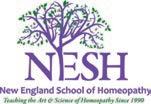



































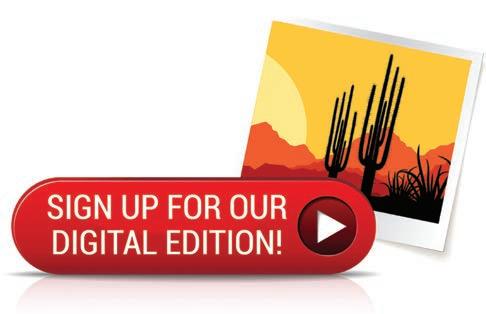








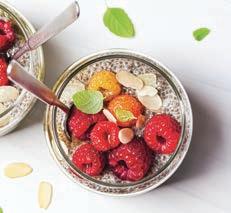
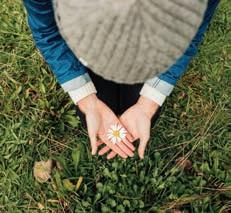

Publisher Tracy Patterson, BSc, MES
Design & Production Vegetorium, LLC
Copy Editor Sara Gurgen, MS
Digital Platforms
Carolyn Coogan Locable
Natural Awakenings – Phoenix Tracy@NaturalAZ.com NaturalAZ.com
CEO Kimberly B. Whittle
COO Michael Bevilacqua
CMO Vee Banionis
Sr. VP Operations Brian Stenzler, DC
National Editor Sandra Yeyati
Editor Brooke Goode
Copy Editor Melanie Rankin
Print Production Specialist Kevin Rankin
Design Director Agnes Mazeikaite
Production Flip180
Executive Admin Julius Frago
Cover image
Ninjuna from Getty Images/CanvaPro
© 2025 by Natural Awakenings. All rights reserved. Although some parts of this publication may be reproduced and reprinted, we require that prior permission be obtained in writing. Natural Awakenings is a free publication distributed locally and is supported by our advertisers. Please call to find a location near you or if you would like copies placed at your business. We do not necessarily endorse the views expressed in the articles and advertisements, nor are we responsible for the products and services advertised. Check with a healthcare professional regarding the appropriate use of any treatment.

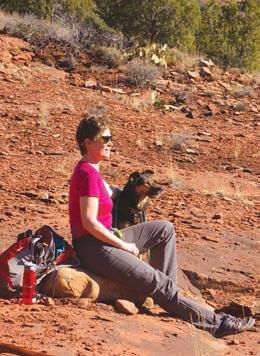
I couldn’t help but think about my relationship with nature when I read the article “Making Time To Marvel” on page 27 in this month’s issue. I grew up in a different time, where I had the freedom to roam in my neighborhood. A wild field, a huge park atop cliffs, a river and my yard were all part of my “playground,” where I cultivated my love for the natural world.
As a young adult, I spent years camping and hiking in the Rocky Mountains every possible chance I could get. What a feeling it was being out there in the middle of nowhere with the brilliant sun, cool breeze and vast views—my reward after a long, sweaty hike up a switchback trail through the trees.
Living on our horse ranch was wonderful as well. We were in the middle of 160 acres in a clearing with forest all around, and a river ran through the north end of our property. It was our own private nature reserve, with moose, deer, elk, bears, mountain lions, coyotes, foxes and endless bird species—eagles, owls, bluebirds and many others. It was a fabulous place to walk our dogs, and the connection with nature was almost intense, as we lived in a little house right in the middle of it all. The wildlife just roamed around as if we were part of the scene, because we were.
Moving to the ocean brought a whole new experience to my life, as this was my first time interacting at a “local” level with such a force of nature. It had a similar wild appeal to the rugged mountains, just in a different form. It became my “new” nature, as I walked on the beach, observed the sea life, and wondered if there would be a bear around each corner as I hiked along heavily vegetated trails. And, surprise, there was a bear from time to time, especially during the salmon run.
Now, living in beautiful Arizona, it’s yet another completely different environment, but the feeling is the same. When I’m out on the trails, whether it’s the red rocks, the high mountain desert or the ponderosa pine forest, it’s still the most humbling and centering experience—and my deepest connection.


Please note that all deadlines (advertising and editorial) are the 5th of the month prior to the edition being published. For example, April 5 is the deadline for all May edition submissions.
Creatine is a compound made by the body that is found in the muscles and brain. People may take it in supplement form to help build muscle and lower injury risk. A small, controlled study published in the journal Scientific Reports evaluated the use of creatine to clear the mental fog that may result from a bad night’s sleep. Fifteen healthy young adults stayed in a laboratory for two nights, five days apart, during which they were kept awake all night.
One night, they received a single dose of creatine, and the other, they were given a placebo. Cognitive tests were conducted before they took the creatine or placebo, and at three other times during the night. The researchers found that a single, high dose of creatine partially reversed some of the cognitive impacts of sleep deprivation. Further research is needed to determine appropriate doses for maximum effect.

The Wall Street Journal reports that scientists at Pennsylvania State University and the University of Adelaide, in Australia, are working on a novel method to fight tooth decay. Different bacteria in the mouth can cause oral disease or prevent it, and the idea is to transfer bacteria from the mouth of a healthy individual to reduce tooth decay in another.
The researchers identified an individual that brushes only once a day, never flosses and has no cavities despite having not visited the dentist in five years. This super-donor's microbiome was so healthy that poor oral hygiene habits did not seem to matter. When the scientists applied plaque from the super-donor to the teeth of rats, the animal subjects showed a significant drop in tooth decay. Clinical trials on humans will begin later this year.
While highly processed foods have been associated with an unhealthy diet, information about the degree of processing has been limited. GroceryDB, a comprehensive database of more than 50,000 food products sold by Walmart, Target and Whole Foods, is the first systematic attempt to quantify food processing.
With the help of a user-friendly interface called TrueFood (True Food.tech), GroceryDB enables consumers to view the level of processing for specific foods, based on a scoring system where 0.0 to 0.2 represents minimally processed items and 0.7 to 1.0 are considered ultra-processed.
The GroceryDB system uses artificial intelligence to examine each product’s ingredient complexity and interactions; presence and quantity of industrial additives; nutritional composition and density; processing methods and techniques; presence of artificial preservatives and enhancers; chemical modifications to the original ingredients; added sugars and their forms; industrial protein sources and modifications; and synthetic micronutrients and fortification.


Approximately 12 million Americans over age 40 have vision impairment, 1 million of which are blind, according to the U.S. Centers for Disease Control and Prevention. Historically, employment opportunities for blind adults have been limited by the inaccessibility or ineffective use of Braille, a system of raised dots that allows visually impaired individuals to read and write.
Scientists are developing new digital technologies to bring Braille text and tactile graphics to the blind in real time. The South Korean company Dot, for example, created an electromagnetic device that moves thousands of pins up and down on a handheld pad. Michigan-based NewHaptics is working on an apparatus that uses air pressure to move the Braille dots on a display.
Other researchers are exploring ways to leverage artificial intelligence to translate books and convert images into Braille more quickly and at a lower cost. American Printing House for the Blind uses Dot technology to create a laptop machine called Monarch that displays 10 lines of Braille and provides a Braille keyboard, as well as word processing, graphics and touchscreen capabilities. The new devices are expensive. Dot Pad retails for $12,000 and the Monarch is $17,900.

Perfluoroalkyl and polyfluoroalkyl substances (PFAS) known as “forever chemicals” have been linked to a number of health issues. In April 2024, the U.S. Environmental Protection Agency labeled a specific PFAS known as perfluoroctane sulfonic acid (PFOS) and its salts and isomers as hazardous chemicals.
A recent study published in Science of the Total Environment reports that a bacterial strain known as Labrys portucalensis F11 consumed 96 percent of the PFOS to which it was exposed over a 194-day period at a contaminated industrial site in Portugal. Scientists hope to use F11 to remediate this form of PFAS from the environment.
Algae are one of the fastest-growing organisms on Earth, and the body weight of many forms are comprised of 30 percent oil. When they are fed sugar, algae increase in size and oil content. Taking advantage of these characteristics, Amsterdam-based manufacturer Corbion is exploring ways to produce and market algae oil as a viable alternative for cooking. The company currently operates a plant in Brazil that ferments algae from the sap of chestnut trees to increase its oil content to 80 percent. The oil is then separated and refined for human consumption.
There are multiple advantages to algae cooking oil. It has 25 percent less saturated fat than olive oil; more heart-healthy, monounsaturated fat than other cooking oils; less polyunsaturated fat than seed oils; and a higher smoke point than many other oils. Switching to algae oils could have benefits for the environment, too, by conserving water and reducing fertilizer use. Until demand increases, however, algae oils remain a high-cost product.
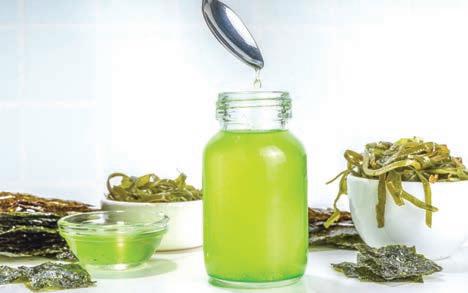

Gardening with native plants is rising in popularity as homeowners look for ways to introduce eco-friendly, low-maintenance features around the house. Whether transforming an entire backyard or incorporating a few purple coneflowers and milkweeds, native landscaping is a simple, yet powerful, way to support a healthier environment. Best results will come by using healthy soil, selecting the right plant for the right place and following recommended care instructions. Here are some of the top reasons to choose native plants.
Support wildlife and pollinating insects. Native plants are the foundation of local ecosystems, providing essential food and shelter for insects, which in turn feed birds and other wildlife. Having cohabited with indigenous flora over time, insect populations often rely on one specific host plant. For example, monarch butterfly caterpillars have adapted to eating only the leaves of milkweed varietals. Homeowners can create a thriving habitat for all fauna by building
a diverse garden that includes indigenous flowering plants from spring through fall.
Conserve water and help prevent erosion. Having adapted over time to local rainfall patterns and soil conditions, native plants are far more drought tolerant than conventional lawns or imported ornamental plants, making them allies in the quest to conserve water and lower utility costs.
Native, deep-rooted grasses can help stabilize soil, improve water absorption and reduce runoff, which in turn helps to prevent flooding and protects local waterways from pollutants that wash off of chemically treated lawns and grimy paved surfaces.
Reduce overall backyard maintenance. Once established, native plants typically thrive with minimal intervention, reducing the need for watering, mowing and chemical treatments. Studies suggest that replacing even part of a lawn with native plants can improve soil quality and lead to
substantial long-term cost savings in irrigation and maintenance.
Enhance natural beauty and resilience. From vibrant, complex flowers to billowing grasses, native plants create diverse and visually appealing gardens that change throughout the year. Because they have evolved with local climate conditions, these endemic species are often more resilient to weather extremes than non-native varietals. They can withstand droughts, high humidity, cold snaps and other stressors, making them a practical and long-lasting landscaping choice.
Maintain natural biodiversity. By adding native ecosystems, homeowners can help enhance and maintain local wildlife populations. Doug Tallamy, founder of the Homegrown National Park movement, encourages individuals to reclaim spaces traditionally dominated by lawns and exotic plants, turning them into thriving ecological corridors.
To learn more, visit Audubon.org and HomegrownNationalPark.org.
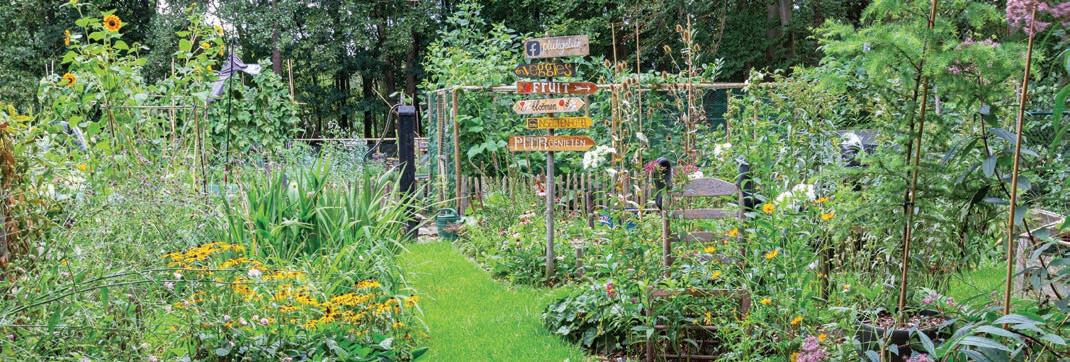
by Carrie Jackson
Acircular economy mimics nature by keeping products and materials in circulation and regenerating their resources. According to the World Health Organization, it offers an avenue to sustainable growth, good health and decent jobs while saving the environment and its natural resources. Although this is not a new concept, an increasing number of businesses across various industries are acknowledging our climate crisis and renewing their dedication to sustainability.
Consumers, too, are recognizing their role in a circular economy and becoming more mindful of how they use their resources. By making conscious choices about their purchases, managing waste and cutting back on consumption, they can positively impact the planet, their wallets and communities at both a local and global scale
Claire Potter is the founder of One Circular World, and author of Welcome to the
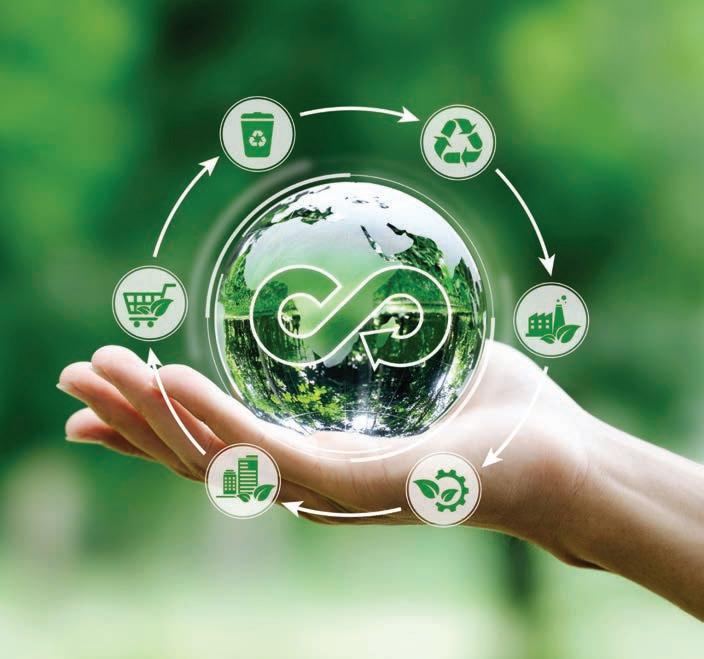
Circular Economy: The Next Step in Sustainable Living. She notes that a circular economy is best described as a series of systems that work like nature does. “No waste is produced in nature, and everything flows,” she says. “Anything not required by one species is used by another or breaks down to provide nutrients for the earth. Nature works in balance with itself, and humans are the only species on Earth that doesn’t do that.”
A circular economy can provide this balance across multiple sectors. “By using a waste stream of material for another purpose, ensuring that the earth is nourished with organic waste, using materials for as long as possible before they are broken down to be used for another purpose, and ensuring that renewable energies are used to make and transport our products, the circular economy feeds into all elements of our lives,” explains Potter.
Consumers can start by cutting down on online shopping, which reduces packaging and prevents unwanted items ending up in landfills. “It is very tempting to click on something and have it arrive the next day, but online shopping is notorious for having excessive amounts of packaging,” says Potter. “See if orders can be combined and packed together, or buy the same item from a physical store where you can try things on before purchasing them. Large volumes of clothing purchased online is returned, and, unfortunately, it is cheaper for the brand to ditch the item than to put it back into their supply chain.”
Although recycling is often touted as a cornerstone of environmental stewardship, Potter asserts, “Recycling won’t save us. We have had the ‘reduce, reuse, recycle’ mantra since around the first Earth Day in 1970, and yet our consumption-based industries have somehow encouraged us to focus on the ‘recycling’ element alone. In circularity terms, the first two are far higher up the hierarchy of desirable actions. Of course, recycling plays a part, but it is a deeply inefficient system.”
As an example, Potter points to the UK where “only around 9 percent of the plastic sent for recycling ever returns as a new item, and the rest ends up being landfilled or incinerated. In some cases, recycled material is exported to developing countries, which increases the risk of it being dumped into various ecosystems.”
Potter suggests a revamping of the old mantra to include refuse, repair, redirect, regenerate and refill. “Recycling is often a very energy- and transport-heavy system, so in circularity terms it is far better to reduce and reuse before you get to recycling, which should be the last resort,” she explains. “Buy the best possible option for longevity, repairability and upgradability; even if it is more expensive, that initial investment can pay out multiple times.”
While it can seem overwhelming to responsibly manage waste, businesses like TerraCycle are stepping in to help by providing Zero Waste Boxes and other wastemanagement solutions to recycle almost
everything—from everyday kitchen waste and cleaning supplies to cosmetics packaging and more. These free and paid solutions are available to individuals, offices, schools and facilities.
Established in 2001, TerraCycle developed its own platform of circularity called Loop. By partnering with retailers (Charlie Banana), brands (Coca-Cola, Evian and Nutella) and supply partners (FedEx), they enable the sale and collection of reusable and returnable versions of conventional, singleuse products, making the process convenient and accessible. People can order boxes from the company to fill with obsolete toys, small appliances, water filters, fabric, candy wrappers and other challenging items, and TerraCycle will take care of the rest.
“What makes something locally recyclable depends on whether your local recycling company can make a profit recycling it,” says TerraCycle CEO Tom Szaky. “If the cost of collecting and processing the waste is lower than the value of the resulting raw material, it will likely be locally recyclable. If the costs are higher, then it likely won’t be. Our specialty is recycling hard-to-recycle items that would typically go to landfills or incinerators—everything from cigarette butts, to beauty empties, to spent toothpaste tubes.”
Circularity has to start with production, says Mary Beth Schaye, a zero-waste consultant and vice president of the Collective Resource Compost Cooperative, in Evanston, Illinois. “When you first design something, you have to think about what’s going to happen to it in the end. It’s a very cradle-to-grave idea,” she points out.

Circularity goes against the current trend of planned obsolescence, a business strategy that encourages consumers to continually buy new products to replace those that become outdated or break down quickly. In contrast, there is a growing interest in a policy known as “extended producer responsibility”, which makes manufacturers take responsibility for their products’ entire life cycle, including the post-consumer stage.
Schaye can’t think of a better way to prevent waste than by simply reducing new purchases. “It can sometimes feel like a burden for consumers to make sure everything goes in the right place,” she says. “It’s better to not have that thing to get rid of in the first place.”
Citing transportation as a barrier, Schaye notes that circularity works best when the circle is smaller. She urges people to look for repurposing solutions within their own communities, suggesting, “If there’s something that you are throwing out habitually, like extra food, boxes or containers, see if there’s someone else who can benefit from it. We encourage people to identify their own reuse pipelines.”
Feeding America estimates that people waste 92 billion pounds of food annually in the United States, filling up landfills and taxing the environment. “When food scraps go to landfill, they create methane, which is a greenhouse gas,” Schaye attests. “Minimizing methane is more impactful than carbon dioxide on reducing the global temperature.”
Composting is an example of circularity that people can understand. “We grow food; we eat the food; and we have food waste that gets composted so that it can enrich the soil to grow more food,” Schaye explains. “It’s easy and immediate. Most people have an option for composting, but they might not know about it.”
A way to reduce food waste is to plan meals ahead of time and avoid over-shopping at the grocery store. “If you know you’re going on vacation or will be eating out several times in the next week, then don’t buy
anything that will expire while you’re gone,” Schaye counsels. “If you do have extras, see if there’s a neighbor or community fridge that can take it. When eating out, try not to order more than you need, but if you think you will have leftovers, then bring your own containers to transport them home.”
Produce doesn’t have to look perfect in order to be consumed. A bruised peach might make a delicious pie, and overripe bananas are the key ingredient to homemade banana bread. If something is getting close to its expiration date, there may be a way to save it. “If you stock up on apples at the farmers market, make sure you properly store the extras to enjoy later. We’ve lost the oldschool wisdom of how to preserve food. Freezing food and using the right containers can give it new life,” says Schaye.
Consumers can also become more mindful of supporting institutions that practice circularity. Potter encourages people to look at their bank accounts, investments and pensions. “Often we do not know where our money goes after we deposit it with our bank. We could be trying our best to live as circularly as possible but have no idea that our hard-earned cash is being used to fund fossil fuel companies, for example. Do a bit of digging into where your money goes, and if you don’t like the answer, switch your money to an ethical bank investment group,” she suggests.
Other changes, such as switching to an energy provider that uses a 100 percent green tariff from renewable energy sources, will have both long- and short-term effects. “Your energy supplier will likely already have a renewable option, so switching might not be too hard and will help to invest in future-proofed systems,” says Potter. “If each of us does what we can, our strengths will overlap, eventually creating a beautiful circle of circularity.”
Carrie Jackson is a Chicago-based freelance writer and frequent contributor to Natural Awakenings. Connect at CarrieJacksonWrites.com.
by Sandra Yeyati
April 22 marks the 55th anniversary of Earth Day, the worldwide annual event that fosters environmental awareness and champions conservation initiatives designed to curb the ravages of climate change. This year’s theme—Our Power, Our Planet—invites 1 billion supporters in 192 countries to unite behind renewable energy with the goal of tripling the global generation of clean electricity by 2030.
“For years, we have been fed the lie that only fossil fuels can power the planet. That is not true,” says Denis Hayes, organizer of the first Earth Day and board chair emeritus of EarthDay.org. “By the 2030s, the largest source of electricity generation on the planet will be solar power.”
Our reliance on fossil fuels for energy has had dire consequences, releasing greenhouse gases and toxic chemicals that drive climate change, pollute the environment and threaten human health. According to EarthDay.org, cutting greenhouse gas emissions diminishes the risk of heatwaves, floods and the spread of infectious diseases. A reduction in air pollution is also expected to decrease respiratory and cardiovascular diseases such as asthma and strokes.
The technology already exists to meet global energy needs with clean, affordable and
renewable power from solar, wind, geothermal, tidal and hydro sources—all of which can be stored in batteries and fuel cells. Wind and solar have become the most cost-effective sources of power, surpassing traditional fossil fuels in affordability. Renewable energy represents a huge economic opportunity estimated to create 14 million new jobs globally, according to the International Energy Agency, an intergovernmental organization that provides data, analysis and policy recommendations on the global energy sector.
Forty-nine countries currently generate more than half of their electricity from clean sources, including Canada, Switzerland, Austria, New Zealand, Brazil, Norway, Sweden and Denmark, while Iceland produces virtually all of its power from renewable sources.
“We need people power to support the big switch to renewable energy,” says Kathleen Rogers, president of EarthDay.org. “We encourage everyone to talk to your local mayor, boss, neighbors, community leaders, and local and national legislators to explore and to champion switching to renewables.”
There are multiple ways to get involved and celebrate Earth Day, so join one of the empowering events in the Phoenix area.

by Jean Hanson
In case you haven’t noticed, a lot is happening in the world today. From political systems to financial and energy systems to health care, most major industries are either undergoing change or finding themselves in trouble. This is the perfect time to re-evaluate our values and ensure these industries align with what the world truly wants and needs.
Changing how we do things isn’t easy. We get used to existing systems and often put up with bureaucracy to avoid learning something new. However, more people are now unwilling to tolerate this. Most desire change but aren’t sure how to make it happen. But change will happen, as there will always be people ready to find ways to make the world better.
What can we do as individuals to prepare for the changes ahead? First, we must be open to new ideas, because that’s the only way to navigate challenging situations. If you disagree with something, ask yourself: Is it because it goes against my values or is it because it’s a new idea? Resistance to change often stems from a fear of losing control. While this doesn’t mean the change is bad, it can signal a reluctance to embrace new perspectives. That’s not easy to admit
for most people, but in this time of major change, becoming more accepting of others’ ideas will help everyone cope with changes without becoming argumentative.
Consider this: Whenever you have the opportunity to explore a topic that is of interest to you, take the time to examine all sides of the issue. Every issue has differing opinions. You must decide where you stand based on your understanding of those perspectives. And if things don’t go your way, find a way to accept it and move on instead of dwelling on it.
We all have opinions, but it’s important to assess whether those opinions are based in truth or hearsay. Hearsay can cloud judgment, making it harder to have a rational discussion. Rather than relying on what you see on TV or social media, base your opinions on your own research. Keep in mind, though, that getting to the truth can be difficult, so use your discernment to evaluate the source of the information. If it comes from a reputable source, allow yourself to form an opinion—even if it differs from the views held by those around you. Sometimes it’s essential to share what you’ve learned so others can become aware of the truth.

When it comes to personal health, many people are becoming disillusioned with the traditional medical system, which often focuses on symptom management rather than addressing the root causes of illness. This shift has led many to seek alternative treatments, such as energy healing. There are many different types of energy healing available, so once again, it’s important to use discernment in choosing the right approach for you. That doesn’t mean you can’t explore different modalities, but rather that you are free to choose the one that resonates with you the most.
Major change takes time. In the meantime, think about how you can take charge of your life. One thing we do have control over is our own bodies. When it comes to health care, take some time to consider what you might be able to do on your own before consulting a doctor.
If stress is causing your issues, there are many ways to alleviate it. Meditation is known to calm the nervous system, but it must be practiced consistently. Harmonic Egg sessions, a type of energy healing that focuses on stress relief, are among the most effective ways to bring the nervous system into balance. Additional sessions targeting specific conditions are also recommended. Healing naturally with sound and light is not only effective but also noninvasive. So, instead of relying solely on your doctor, try utilizing other options first. You might be surprised by how much better you feel when you take a natural approach.

Jean Hanson is coowner of Realign Your Life Wellness Center, in Mesa. She is a certified Body Code practitioner, Higher Guidance Life Coach and author of Trust Your Higher Guidance: Align Your Life to Manifest the Joy and Success You Deserve. Realign Your Life Wellness Center also features the Harmonic Egg sound and light therapy, Life Force Energy with Sound, and sound baths. Appointments can be booked online at RealignYourLifeAZ.com or by calling 480-306-7321. See ad, page 21.
Advertorial
by Madiha Saeed, M.D.
According to the Mayo Clinic, fibromyalgia is characterized by widespread musculoskeletal pain and fatigue, accompanied by sleep, memory and mood problems. It affects about 4 million Americans and is most often diagnosed between the ages of 35 and 45. Adult women are twice as likely as men to suffer from this chronic, debilitating condition.
“Although the exact cause of fibromyalgia is not known, many researchers have come to believe that it results from an overactive nervous system that misfires, making pain signals stronger and more persistent. It appears that the brain and nerves are not processing pain messages correctly, leading to heightened sensitivity and discomfort. Traditionally, treatments have been focused on managing symptoms rather than addressing the root causes, but exciting advances in medical research and treatment are on the horizon,” says Jane Hogan, a functional medicine certified health coach, founder of the Wellness by Design podcast and host of the Becoming Pain-Free 2.0 Summit last November.
Dr. Evan Hirsch, a functional medicine practitioner and CEO of EnergyMD, states, “Fibromyalgia is an autoimmune disease, or at least inflammation, and all inflammation is essentially autoimmune. If that autoimmunity ends up attacking the muscles, you get fibromyalgia. Essentially, the immune system is reacting to something that is in the body. When that something is in the
muscles, the immune system is attacking that thing in the muscles.”
Hirsch suggests that the offenders might be a combination of heavy metals, chemicals, molds, infections and nervous system dysfunction. He stresses that if symptoms began after COVID, then it is important to address that infection. Bartonella bacteria, which are spread to humans by fleas, body lice or sand flies, can live in the muscles, causing inflammation—and pain—in the tendons and ligaments.

Stress is a major risk factor for many chronic health conditions. According to Hogan, “A key player in calming fibromyalgia pain is the vagus nerve, which activates the nervous system’s parasympathetic state, or relaxation response. A promising area of research is investigating noninvasive vagus nerve stimulation as a safe and effective mode of pain management for fibromyalgia patients. Methods of selfstimulation of the vagus nerve include deep diaphragmatic (or belly) breathing, body movement, reflexology, gargling, humming and cold-water immersion. Trauma can also contribute to chronic pain, so incorporating more mind-body techniques can improve overall health and wellness.”
Traditionally used for opioid addiction, naltrexone has been studied for its potential to reduce pain and inflammation in fibromyalgia. A 2023 systematic review published in the Journal of Pain Research reported that low-dose naltrexone appears to be effective and safe in the symptomatic management of fibromyalgia. The researchers noted that additional studies were needed to determine dosage, frequency and duration recommendations.
The gut microbiome houses 70 to 80 percent of the body’s immune cells. “Anything that is in the gut that is not supposed to be there, including foods, can cause inflammation, and inflammation in the gut leads to inflammation in other parts of the body, which can cause pain in the muscles and fibromyalgia,” says Hirsch. “Gut health and the health of the microbiome is critical for lowering chronic inflammation and pain.”

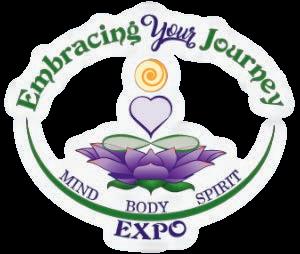


He recommends focusing primarily on fiber-rich foods, healthy fats and lean protein, as well as prebiotic, probiotic and post-biotic foods. Removing ultra-processed foods and common food sensitivities can also help to lower inflammation in the gut.
A fecal transplant from a healthy donor may be beneficial to replace vital gut bacteria; however, the transplant may have to be repeated multiple times over extended periods, says Hirsch. In his experience, patients are unable to keep up the treatments for a variety of reasons. “If they don’t keep doing it, they aren’t going to continue to get the benefits,” he points out.
The world of fibromyalgia treatment is rapidly evolving with new therapies, from regenerative medicine and targeted drug therapies to integrative mind-body treatments. It is exciting to see this new shift toward personalized, effective care that addresses physical, mental and emotional aspects of fibromyalgia, bringing new possibilities for pain relief and an improved quality of life.
Madiha Saeed is a holistic, functional and integrative doctor in Naperville, Illinois, and director of education for Documenting Hope and KnoWEwell.


by Zak Logan
The thought that a few extra minutes of movement each day could transform our health, energy and happiness is the motivation behind the American Heart Association (AHA) promotion of April as Move More Month. For avid fitness enthusiasts, as well as those looking to take the first step toward an active lifestyle, this is the time to celebrate movement in all its forms.
Physical inactivity has become a creeping health crisis. According to guidelines published by the U.S. Department of Health and Human Services, nearly 80 percent of adults fail to meet the recommended levels of aerobic and muscle-strengthening activity. The AHA reports that cardiovascular and heart disease affects nearly half of all American adults, causing direct and indirect costs that are projected to reach $1.1 trillion by 2035, according to RTI International, a nonprofit research institute.
The Harvard T.H. Chan School of Public Health reports that a healthy lifestyle, which includes regular exercise, may prevent 80 percent of sudden heart attacks and cases of coronary artery disease, as well as 50 percent of strokes caused by blood clots. The health benefits are reason enough to hit the gym or go out for a morning jog. Move More Month inspires us to incorporate movement into a busy life and, most importantly, find joy in an active lifestyle.
There is no one-size-fits-all formula for fitness, and Move More Month is an opportunity to explore the options that best match our personality, lifestyle and fitness level.

• Fitness boot camps are high-energy workouts in an energizing environment that welcomes beginners and experienced fitness lovers alike. Accept the challenge with a local trainer, at a CrossFit gym or with the guidance of an app like BurnFit.
• Dance classes such as Zumba, salsa or hip-hop can be fun and immersive workouts that don’t feel like exercise at all.
• Yoga in the park combines mindfulness with a great stretch and a dose of natural vitamin D. Many communities offer free sessions.
• Water sports like kayaking and paddleboarding develop balance, core strength and endurance while communing with nature.
• Social sports, including golf, pickleball and tennis, not only burn calories but also offer camaraderie and fun.
• Daily walks are the cornerstone of an active lifestyle. Try to reach 10,000 steps with walks around the neighborhood or local park, remembering to compound the benefits by using this time outdoors to calm the mind and invigorate the spirit.
• Team sports like soccer, basketball or softball offer wonderful workouts combined with competitive team play at local parks or sports clubs.
Making the shift from a sedentary lifestyle can feel daunting, but every huge transformation starts with a single step. Try these practical tips to ease into an active lifestyle.
• Set achievable goals. Start with 10 minutes of movement a day and gradually extend the time.
• Integrate movement throughout the day. Stretch while watching TV, park the car farther from work or stores to

take extra steps, or choose the stairs instead of the elevator whenever practical.
• Use technology. Fitness trackers by Fitbit, Apple, Samsung and Garmin help monitor progress, set challenges and offer that extra motivational nudge.
• Applaud everyday wins. Even tiny changes matter. Try a new dance move each day. Stretch in the mornings or set reminders to get up and move during long work hours.
• Avoid perfectionism. What matters is consistency. All movement is progress, so celebrate it.
We often think of exercise as a solo endeavor, but getting others involved can be a great tool for staying motivated. Local communities are brimming with opportunities to connect with others, offering interactive activities such as running clubs, group fitness classes, sports leagues and cycling tours. Many neighborhoods have online groups or bulletin boards that promote meetups, classes and fitness events.
Movement isn’t just about physical health; it’s about the joy of discovering what the body can do, the pride in building a healthier routine and the sense of belonging to a group of like-minded individuals. Don’t wait for tomorrow to get started. Lace up, stretch out and start moving today.
Zak Logan is a freelance health writer dedicated to getting back to basics.
Our beautiful herb shop is FOR SALE!
Have you always wanted to own an established, well-respected business? Our 16-year reputation speaks for itself with a strong customer base (in person & online), a turn-key operation with an extensive ‘brand-recognized’ product line.

We are open regular business hours during this search for our next lucky proprietors! For further information, contact Madalyn at Madalyn@SWHerb.com.
REMS Echolight is superior to DXA. Get the most accurate, radiation-free bone screening to protect your future and take control of your health and longevity.

INVEST IN YOUR BONES, INVEST IN YOUR LIFE!



by Tom Whittle
As the demand for energy continues to rise, the need for renewable, natural sources has never been clearer. Groundbreaking advancements in clean energy are poised to replace—or, at the very least, significantly diminish—our dependence on fossil fuels, offering a path toward impactful reductions in greenhouse gas emissions. With broad acceptance of such innovations, a green, sustainable future is within reach.
A single hour of sunlight hitting the planet contains more energy than we use in a year, but the challenge is to harness it efficiently. One innovation stacks an ultra-thin layer of perovskite minerals atop a standard silicon solar cell to capture a broader spectrum of sunlight.
These so-called “tandem solar cells” boast an impressive efficiency of more than 34
percent, compared to 20 percent with most residential solar panels. A single tandem panel can generate significantly more electricity, offering a better return on investment while conserving roof space. In September 2024, Britain’s Oxford PV began selling these panels in the United States.
The use of floating solar panels increases opportunities for energy production, minimizes land use, reduces water evaporation and serves as shade over a body of water. The solar panels are cooled by the water, making them more efficient. A recent study published in Solar Energy estimated that federally controlled reservoirs using floating panels could generate about half of future U.S. solar generation needs.
Ambient Photonics, in California, was inspired by photosynthesis to develop a solar cell that can generate power from low-level
ambient light rather than direct sunlight. These indoor solar cells use a special dye to absorb light and create energy, making them more versatile and efficient than traditional solar panels. Because they are thin, flexible and can be applied to most surfaces, they could potentially replace batteries.
Korean scientists published the results of their work in fabricating flexible, transparent solar cells in the journal Nature in 2023. Commercialization of such technology would allow windows and skylights to bring in natural light while contributing to the building’s energy supply.
Next-generation turbine designs are setting new benchmarks for wind energy performance and efficiency. General Electric’s Haliade-X offshore wind turbine with 350-foot-long blades has the capacity to
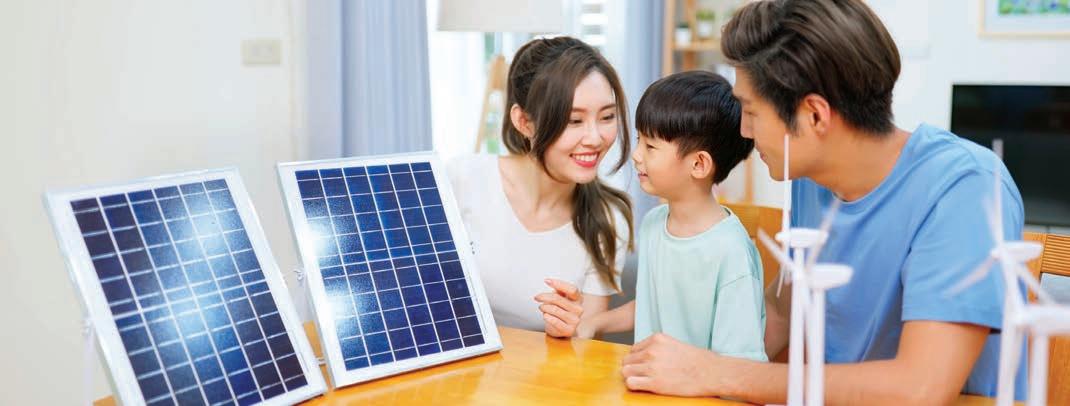

generate more than 12 megawatts of power, doubling the energy of their predecessors.
Offshore wind farms, where winds are stronger and more consistent, are also moving to new frontiers. Employing floating turbines attached to buoys, the Hywind project located 87 miles off the coast of Norway is estimated to eliminate 200,000 tons of carbon dioxide emissions annually.
Progress has also been made to tackle the environmental challenges of retired turbine blades that are comprised of fiberglass and carbon fiber. Researchers from the University of California, Davis, are testing biodegradable blades using eco-friendly materials like bamboo, mycelium and agricultural waste.
Stora Enso, one of the largest private forest owners in the world, has partnered with Voodin Blade Technology of Germany to make sustainable wooden blades and has also partnered with Modvion of Sweden to make wood the material of choice for their wind turbine towers.
Artificial intelligence is revolutionizing the renewable energy landscape, enabling realtime monitoring and optimization of energy generation and distribution across solar, wind and geothermal sources, optimizing energy storage solutions and detecting maintenance needs before issues arise to ensure peak performance year-round.
Even with its impressive growth, the renewable energy sector faces several challenges.
Because the efficiency of solar and wind power is dependent on weather conditions, advancements in energy storage are critical to bridge the gaps between supply and demand. This is where high-capacity batteries and pumpedstorage hydroelectricity come in.
Existing energy grids and infrastructure were designed with fossil fuels in mind, whereas renewable sources are decentralized and require different setups. Investments are needed to modernize grid systems to handle these novel demands.
Public resistance, lack of awareness or misconceptions about renewable technologies can slow adoption rates. Empowering local communities to participate in renewable energy projects can foster a sense of ownership while addressing specific local needs and concerns.
Despite these obstacles, the promise of a sustainable energy future that benefits people and the planet is worthy of the effort.
Tom Whittle is the national publishing manager of Natural Awakenings magazine.

Spiritual Development Classes to expand your consciousness
Intuitive and Practical Workshops for new learning
Private Healing and Reading sessions for Guidance and Balance
Meditations and Spiritual Expos for your Mind, Body and Soul
N. Frank Lloyd Wright Blvd., Suite #E-16, Scottsdale, AZ 85259


by Marlaina Donato
Acompromised gut can make us susceptible to a host of conditions, including depression, chronic disease and viruses such as COVID-19. To fortify us against such illnesses and generally strengthen the digestive tract, prebiotic foods like asparagus, dandelion greens, bananas, leeks and Jerusalem artichokes can be quite helpful.
“Prebiotics are like fertilizer for your gut garden, helping it flourish so your whole body can thrive,” explains Donna Schwenk, author of Cultured Food for Life. “When you consume prebiotics, they pass through the digestive system undigested and become fuel for the friendly bacteria in your colon. This process helps the ‘good guys’ thrive, increasing their numbers and supporting a healthy balance of gut flora.”
A harmonious mixture of prebiotics and beneficial intestinal flora—known as synbiotics—can help ward off illnesses, lower “bad” cholesterol and reduce chronic gut inflammation, which is linked to the development of tumors and colorectal cancer. A review published last year in the journal Foods suggests that adding prebiotics to the diet could improve cognitive function, relieve symptoms associated with inflammatory bowel disease and osteoporosis, and even resolve gastrointestinal disorders that plague up to 70 percent of individuals on the autism spectrum.
Adding healthful prebiotics can be as simple as dropping a few raspberries, blueberries
or strawberries into unsweetened yogurt or kefir. Dandelion greens, which are packed with inulin, can be tossed into salads, sautéed with a little garlic and olive oil, or added to smoothies. Leeks, which are mild and sweet, can be enjoyed in soups, sautés, quiches, miso broth or cream dips. Other delicious prebiotic ingredients include bananas, flax and chia seeds, cacao nibs, lentils, oats, barley, chicory and jicama root, almonds, seaweed and avocados.
Schwenk suggests an easy gourmet dish that features roasted asparagus, apples and Jerusalem artichokes over a bed of greens tossed with a probiotic-rich salad dressing. She notes, “Apples are rich in pectin, a soluble fiber and powerful prebiotic that ferments in the gut and feeds beneficial bacteria like Akkermansia muciniphila, which play a vital role in maintaining and strengthening the gut lining.”
According to Schwenk, refrigerated kimchi and naturally fermented sauerkraut are rich in Lactobacillus plantarum, a powerful probiotic that thrives during fermentation, breaking down sugars and promoting a healthy microbiome. Benefits include nutrient absorption, mood support and enhanced immune function.
Renee Barasch, a certified digestive specialist and owner of Digestive Health Solutions, concurs that these probiotic foods can aid in balancing blood sugar, insulin resistance and digestive woes like constipation, diarrhea, bloating, heartburn, acid reflux and gas. On the other hand, she cautions that fermented ingredients can be too high in histamine and thus cause uncomfortable digestive issues for some people.
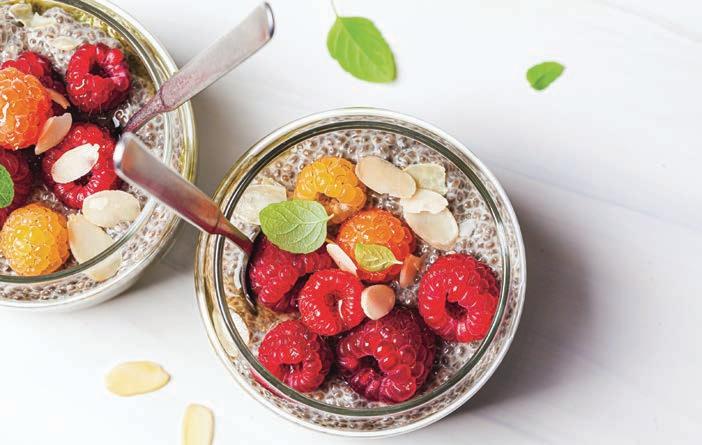
“Folks need to keep in mind their unique gut microbiome,” says Barasch. “Some people will feel gassier or bloated from some of these foods, depending upon their gut health. I use the BiomeFx stool test to identify the presence of histamine, estrogen, hydrogen sulfide and other things that could cause gut issues.”
Findings published in the Journal of Advanced Research in 2020 suggest that certain types of gut flora could play a role in the development of inflammatory bowel diseases.
Prebiotics like garlic can become antagonists for those that have an overabundance of certain types of intestinal microbiota. Garlic can also lead to high concentrations of hydrogen sulfide, which can contribute to gut inflammation.
Schwenk advises, “Introducing prebiotic foods gradually is important to avoid stomach discomfort, especially if you’re new to them. Prebiotics feed your gut bacteria, which can produce gas as they ferment the fibers, so a slow and steady approach is best.”
This easy-to-prepare salsa is bursting with flavor and health benefits. Tomatoes are an excellent source of the antioxidant lycopene, while garlic and onion are prebiotics. The recipe also calls for a probiotic culture to support gut health with live probiotics. It is a perfect way to introduce cultured foods to hesitant eaters.
6 large ripe tomatoes
2 small onions
2 small, red or green peppers
2 4-oz cans chopped green chilies, with juice
2 cloves garlic
2 tsp paprika
2 tsp ground cinnamon
4 tsp chipotle powder
1 Tbsp raw sugar or Sucanat
⅛ tsp veggie starter culture (or 2 Tbsp kefir whey)
1 tsp Celtic sea salt
Combine all ingredients, except the starter culture, in a blender or food processor until chunky or smooth, depending on preference.
Stir in the veggie starter culture or kefir whey, making sure it is well incorporated.
Transfer the salsa to jars, seal with a secure lid and ferment at room temperature. After two days, store in the refrigerator and enjoy.
Recipe and image courtesy of Donna Schwenk.

She recommends eating prebiotics together with probiotics like yogurt, kefir or kimchi so the gut can handle the increase in fiber more effectively. Begin with one or two tablespoons per meal to slowly introduce the beneficial bacteria into the system. “Kimchi and kraut are versatile,” Schwenk remarks. “You can enjoy them as a side dish, mix them into fried rice or even stir them into soups after cooking to preserve the live probiotics.”
Marlaina Donato is an author, artist and composer. Connect at WildflowersAndWoodSmoke.com.
This smoothie is packed with gut-healthy probiotics from kefir and antioxidants from blueberries, making it a powerful tool to support urinary tract health and boost the microbiome. Kefir provides a variety of good bacteria, while blueberries and their juice contain compounds that can help prevent bacterial growth by depriving bacteria like E. coli of the iron they need to thrive.
½ small banana, frozen into chunks
¾ cup kefir
½ cup coconut milk
½ tsp vanilla
1 cup frozen blueberries 1-2 tsp honey
Place all ingredients in a blender and blend until smooth. Pour into a glass and enjoy immediately.
Optional: Add a prebiotic powder like Prebio Plus to enhance good bacteria growth. Start with small amounts to avoid discomfort as the gut adjusts.
Recipe and image courtesy of Donna Schwenk.

by Christine Connors
Cooking with children teaches them valuable life skills, strengthens family bonds and promotes healthy eating habits. “It’s important to create positive experiences in the kitchen with our kids as early as possible. We want them to feel that the kitchen is a place they belong,” says Katie Kimball, creator of the Kids Cook Real Food eCourse and #LifeSkillsNow video workshops.
A study published in the Journal of Nutrition Education and Behavior involving more than 1,200 third-graders, of which 49 percent were overweight or obese, found that when the children were invited to prepare food with their families, they were more willing to taste a vegetable and ended up consuming more fruits and veggies, which are essential to health and the prevention of disease.
Here is a guide on how to cook healthy meals with kids while also teaching them safety and hygiene protocols, measuring tips, fine-motor skills, time management and an appreciation for the effort, dedication and fun that is involved when creating a delicious meal for the family.
Good hygiene practices are essential in food preparation. “Teach your children to wash their hands thoroughly before and after handling food, and to tie their hair back,” says Lynn Feder of Lynn’s Life Bakery. “Keeping the kitchen clean, including washing fruits and vegetables, cleaning work surfaces and using separate cutting boards for raw meat and vegetables is very important. Take care when using knives and electric gadgets. It is
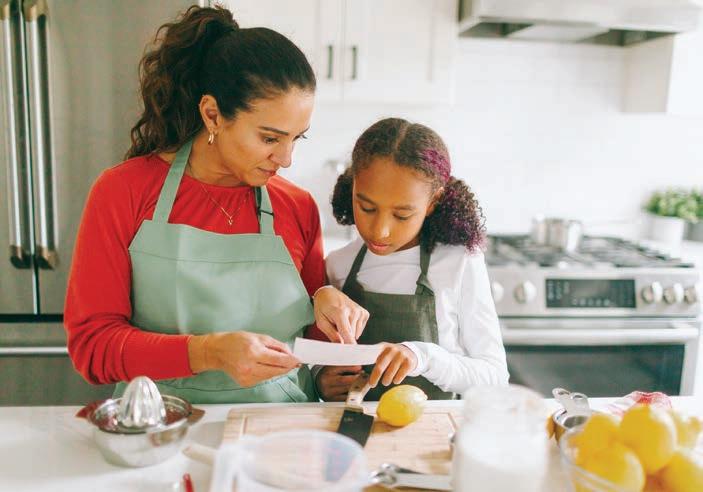
easy to make mistakes, so always make sure you are safe.”
Cooking together provides an excellent opportunity to teach kids about measuring ingredients. Show them how to use measuring cups and spoons accurately. This not only helps them understand recipes but also reinforces basic math skills such as fractions and volumes.
Tasks like peeling, chopping, stirring and mixing help develop fine motor skills. Provide age-appropriate tools and tasks that allow children to practice these skills safely. For younger kids, activities like tearing lettuce, mashing potatoes or stirring batter can be both fun and educational. “You can engage your little ones in the kitchen as early as 18 months to 2 years old, cutting bananas or pouring milk on oatmeal,” Kimball points out.
Cooking requires multitasking and time management. Teach children how to read a recipe from start to finish before beginning. Working together, plan out the steps and determine which tasks need to be done first. This helps them learn to organize their time and develop a sense of responsibility.
Involving kids in cooking helps them appreciate the effort that goes into preparing a meal. “For ages 11 and above, taking over one meal a week helps them develop time management skills and executive
functioning,” explains Kimball. Encourage them to taste their creations and share them with the family. This not only boosts their confidence but also instills a sense of pride and accomplishment.
“The most important thing is to have fun in the kitchen,” says Feder. “I love to decorate my food. When something looks beautiful our brains tell us that it looks beautiful and delicious. Try it—it is so much fun.”
Involving kids in the kitchen fosters a lifelong appreciation for healthy eating and gives them the tools they need to be confident and capable in the kitchen and beyond. Start with simple recipes and gradually introduce more complex tasks as their skills grow. Enjoy their meals together as a family, and praise them for their culinary contributions.
• Rainbow Veggie Wraps: Have the kids choose colorful veggies to fill whole wheat wraps. They can practice chopping, grating and assembling.
• Fruit and Yogurt Parfaits: Layering fruit, yogurt and granola in a clear glass

is a fun and nutritious activity that promotes creativity and fine motor skills.
• Mini Pizzas: Use whole wheat English muffins as the base and let kids add their favorite healthy toppings. This is a great way to encourage them to try new vegetables.
Christina Connors is a writer, singer and creator of a YouTube series for children. Learn more at ChristinasCottage444.com.

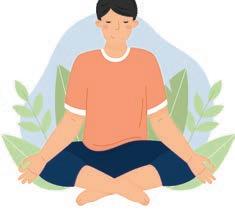

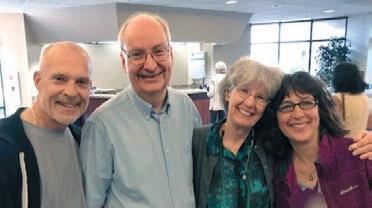

Hope to see you soon!
by Ruth Roberts, DVM, CVA, CVH, CVFT, NAN
Ahealthy urinary system in cats depends on a balanced diet to prevent issues like feline lower urinary tract disease (FLUTD), which affects the urethra and bladder of cats, creating major health risks and causing discomfort. Affected cats may scream in pain, pass very tiny amounts or strain to urinate. Some start urinating outside the litter box, usually on cool places like bathtubs or tile floors, or have blood in their urine.
Poor food choices, especially dry food, can disrupt urinary function, leading to pain, frequent urination and dangerous blockages. The right diet can help manage inflammation, support the bladder and speed up recovery, so proper food selection is needed for prevention and healing.
A study in the Journal of Feline Medicine and Surgery noted that FLUTD can lead to painful urination and blockages caused by struvite crystals that become wedged within the urethra. Researchers suggested that dry food can worsen the condition because the lower intake of water causes urine to be more concentrated, thereby increasing the risk of crystal formation.
“Commercial dry cat food frequently lacks the necessary moisture and contains preservatives, fillers and incomplete nutrients,” says Marketa Jefferson, a holistic pet health coach. “A moisture-rich diet, such as homemade or raw food, is essential for preventing dehydration and reducing the risk of urinary issues like urinary blockages and FLUTD, as cats have a naturally low thirst drive.”
She recommends a diet with high-quality, species-appropriate ingredients tailored to support a cat’s urinary health. “A homemade diet gives pet owners full control over what goes into their cat’s food, ensuring it is fresh, balanced and free from unnecessary additives,” she explains. “Proper hydration is one of the most important factors in maintaining a healthy urinary system, and fresh food provides muchneeded moisture that kibble lacks.”
“Urinary diets for cats should include high-quality animal proteins, such as deboned meat and organ meats, along with essential fatty acids like fish oil,” says Jefferson. “Adding the right vitamins and minerals is crucial, and small amounts of vegetables can also be beneficial.”
It may take some time and patience to convince cats that are used to eating kibble to switch to a homemade FLUTD diet. “In my experience with three cats, they all eventually switched to homemade food and love it now, but one of them took over a month to fully adapt,” Jefferson points out, adding that one of her cats lost five pounds after switching to a healthier homemade diet, which was a huge health improvement.
Certain natural supplements can be beneficial for feline urinary health. “Rather than relying on antibiotics for urinary tract

Inspiration infections, I use natural remedies to support bladder health, as well as PEA [palmitoylethanolamide], a medicine that can ease discomfort and support the urinary tract,” says Jefferson. “Chinese herbs can help maintain kidney and bladder function, while cranberry extract may prevent bacteria from adhering to the urinary tract. Marshmallow root is another excellent remedy because it has antiinflammatory properties and helps soothe bladder irritation, while vitamin C supports immune function and omega-3 fatty acids help reduce inflammation.”
Jefferson emphasizes that prevention starts with proper hydration and environmental management. “Eating moisture-rich FLUTD cat food is crucial for staying hydrated and flushing bacteria from the body. Keeping several water bowls around the house or using a water fountain can encourage drinking,” she explains.
Additionally, maintaining a clean litter box is essential because it promotes proper usage and allows for better urinary health monitoring. “I personally use Pretty Litter because its crystals change color in response to urine acidity and alkalinity, providing an early indication of potential health issues,” Jefferson points out.
“Minimizing household stressors can also greatly support both urinary and overall well-being,” says Jefferson. “Mental stimulation is just as important—interactive toys, scratching posts and enrichment activities help keep cats engaged and active, reducing stress levels.”
Jefferson also points out the importance of monitoring urine acidity, noting, “Keeping an eye on your cat’s urine pH is crucial, especially if they are prone to urinary issues. The ideal range is between 6.5 and 7. If it reaches 8 or higher, that may signal an infection or underlying issue that needs veterinary attention.”
Ruth Roberts is an integrative veterinarian and holistic health coach for pets, as well as the creator of The Original CrockPet Diet. Learn more at DrRuthRoberts.com.
by Marlaina Donato
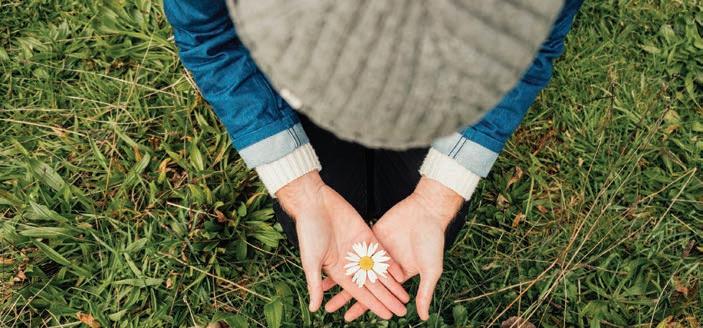
Anyone headed for the woods after a challenging week or seeking the silent counsel of the constellations during grief knows the truth in Albert Einstein’s statement, “Look deep into nature, and then you will understand everything better.”
Many may remember seeing the ocean for the first time and feeling magnificently insignificant while standing before its breaking waves. From the microscopic realms of a drop of pond water to the geometric wonder of snow crystals or the quickly changing murals of clouds, Earth speaks to us if we pause long enough to pay attention.
It is easy to feel pressured into providing our children with the latest technology and common to rush through our schedules, never glancing out the window while zooming from point A to point B. Despite the best intentions, our species has lost the innate and sublime capacity to be awed by what is greater than ourselves.
We can find humility once more in a single blade of new grass, or soulful sustenance by
tuning our ear to April birdsong wafting in through an open window. We can help our children establish spiritual roots by introducing them to mighty oaks, vibrant wildflowers, dappled forest trails and quiet corners of the city park.
With our attention constantly interrupted by ubiquitous, trivial distractions, making time to dialogue with nature and the planet has become an urgent necessity, one that can seem unimportant until we realize how long it has been since we fully exhaled or noticed anything beautiful.
Each spring, the natural world goes about its own whirlwind business of building nests, birthing the next generation, pushing through hard soil and bursting into blossoms that will later become fruit. When was the last time we paused to respond to the real world? May we never be too busy, too old or too jaded to gather handfuls of overlooked miracles.
Marlaina Donato is an author, visionary painter and composer. Connect at WildflowersAndWoodSmoke.com.
Make a meaningful impact in your community by becoming the owner of a Natural Awakenings magazine. Empower others with current, valuable insights and resources to enhance their physical, mental, emotional and spiritual well-being.
As a franchise owner, you’ll inspire positive change, provide readers with tools for healthier living and connect local businesses with an audience eager for transformation.
Why Own a Natural Awakenings Magazine?

n Create a Healthier Community: Be the go-to resource for wellness and personal growth in your area.
n Boost Your Income: Take control of your financial future with a proven business model.
n Enjoy a Flexible Lifestyle: Work from home while pursuing a fulfilling, dynamic career.
n A proven business model with low startup costs.
n Comprehensive training and friendly, ongoing support.
n Flexible work schedule with many work-from-home opportunities.
n Access to a network of like-minded franchise owners.
n Financing Options Available.
Join a thriving network of passionate franchise owners reshaping the future of holistic health and wellness.
Call 239-206-2000 for a FREE evaluation of your community’s potential. Learn more or apply today at: Corp.NaturalAwakenings.com

or learn more, visit Corp.NaturalAwakenings.com.
Add Your Community to Where Natural Awakenings Is Now Publishing:
• Atlanta, GA
• Boston, MA
• Broward County, FL
• Bucks/Montgomery Counties, PA
• Central Florida/Greater Orlando, FL
• Central New Jersey
• Charlotte, NC
• Chicago, IL
• Columbia, SC
• Dallas, TX
• Daytona/Volusia/Flagler Counties, FL
• Detroit/Wayne County, MI
• Fairfield & Southern Litchfield Counties, CT
• Gainesville/Ocala/The Villages, FL
• Grand Traverse Region/Northern Michigan
• Greater Ann Arbor, MI
• Greater Lansing, MI
• Greater Oakland, Macomb, Livingston, Genesee, MI
• Gulf Coast, Alabama/Mississippi
• Hartford/Tolland, CT - Coming soon
• Houston, TX
• Hudson County, NJ
• Jacksonville/St. Augustine, FL
• Lancaster/Berks, PA
• Lehigh Valley, PA
• Long Island, NY
• Milwaukee, WI
• Monmouth/Ocean Counties, NJ
• Naples/Fort Myers, FL
• New Haven, CT
• New London/Windham, CT - Coming soon
• New York City, NY
• North Central New Jersey
• North New Jersey
• Northwest Florida
• Palm Beach, FL
• Philadelphia, PA
• Phoenix, AZ
• Pittsburgh, PA
• Rhode Island
• Richmond, VA
• Sarasota, Manatee, Charlotte and DeSoto Counties, FL
• South Central Pennsylvania
• South Jersey, NJ
• Southeast North Carolina
• Space & Treasure Coast, FL
• Tampa, FL
• Tucson, AZ
• Twin Cities, MN
• Westchester/Putnam/Dutchess, NY
• Western Michigan

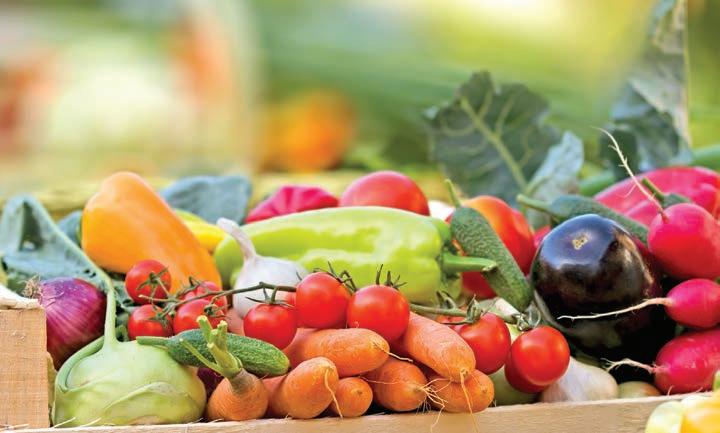
NOTE: Please check market websites and ArizonaCommunityFarmersMarkets.com for more information on days and hours, and any restrictions.
Ahwatukee Farmers Market
4700 E Warner Rd, Phoenix
Sundays Oct-May 9am-1pm Jun-Sep 8am-11am
Facebook.com/AhwatukeeFarmersMarket
Carefree Farmers Market
1 Sundial Circle
Fridays Oct-May 9am-1pm Jun-Sep 8am-11am
Facebook.com/CarefreeFarmersMarket
Downtown Chandler Farmers Market
3 S Arizona Ave
Saturdays Oct-May 9am-1pm Jun-Sep 7am-10am
DowntownChandler.org/events/farmers-market
Downtown Mesa Farmers Market
1 E Main St
Saturdays 8am-noon dtMesaFarmersMarket.com
Downtown Phoenix Farmers Market 720 N 5th Street
Saturdays Oct-May 8am-1pm
May-Oct 7:30am-11:30am DowntownPhoenixFarmersMarket.org
Gilbert Farmers Market
222 N Ash St
Saturdays Oct-Apr 8am-noon May-Sep 7-11am GilbertMarket.com
High Street Farmers Market
5415 E High St, Phoenix
Sundays Oct-May 9am-1pm
Facebook.com/Farmers-Market-on-HighStreet-2244771575799425
Mommas Organic Market
Arrowhead Farmers Market
7780 W Arrowhead Towne Center, Glendale
Saturdays Oct-Apr 9am-1pm | May-Sep 8-11am
Facebook.com/Getlocalazfarmersmarkets GetLocalArizonaEvents.com
Mommas Organic Market
Glendale Farmers Market at Cabela’s 9380 W Glendale Ave, Glendale
Sundays Sep-May 10am-2pm | closed for summer Facebook.com/Getlocalazfarmersmarkets GetLocalArizonaEvents.com
Ocotillo Farmers Market
2577 W Queen Creek Rd, Chandler
Sundays Oct-May 9am-1pm ArizonaCommunityFarmersMarkets.com/ ocotillo-farmers-market
Old Town Scottsdale Farmers Market
3806 N Brown Ave
Saturdays Oct-Apr 8am-noon, May-Jun 7-10am
Facebook.com/OldTownScottsdaleFarmersMarket
Power Road Farmers Market
4011 S Power Rd, Mesa
Monday-Saturday 9am-5pm | Sunday 9am-4pm PowerrdFarmersMarket.com
Roadrunner Park Farmers Market
3502 E Cactus Rd, Phoenix
Saturdays Oct-May 8am-noon | Jun-Sep 7-10am
Facebook.com/RoadrunnerParkFarmersMarket



Singh Meadows Farmers Market 1490 E Weber Dr
Fridays, Saturdays & Sundays 8am-2pm
Facebook.com/SinghFarms
Sun City Farmers Market 16820 N 99th Ave
Thursdays Oct-May 9am-1pm Facebook.com/Sun-City-Farmers-Market631299790224049
Uptown Farmers Market 5757 N Central Ave, Phoenix Wednesdays Oct-Apr 9am-1pm & May-Jun 8am-noon
Saturdays Nov-Apr 8am-1pm & May-Oct 8am-noon
UptownMarketAZ.com
Verrado Community Farmers Market N Market Pl & W Main St, Buckeye Sundays Oct-Jun 9am-1pm Facebook.com/VerradoCommunityFarmersMarket
Farmers Market in Old Town Square 1042 N Main St, Cottonwood Wednesdays 3-7pm (check months/times throughout year)
Facebook.com/FarmersMarketatOldTownSquare
Flagstaff Community Farmers Market 211 W Aspen Ave, City Hall Parking Lot Sundays May-Oct 9am-1pm FlagstaffMarket.com
Prescott Farmers Market
Dignity Health, YRMC 900 Iron Springs Rd, Miller Valley Lot Saturdays Nov-Mar 9:30am-12:30pm Apr-Oct 7:30am-noon PrescottFarmersMarket.org
Sedona Community Farmers Market
Wells Fargo Bank Parking Lot 2201 W State Rte 89A, West Sedona Sundays May-Oct 8am-noon Nov-Apr 11am-3pm Sedona-Farmers-Market.com
Verde Valley Farmers Market Hollamon St and Main St, Camp Verde Saturdays May-Oct 8-11am Facebook.com/VerdeValleyFarmersMarket
Windmill Park Farmers Market
9950 E Cornville Rd, Cornville Thursdays 2-6pm (check months/times throughout year)
Facebook.com/WindmillParkFarmersMarket



Connecting you to the leaders in natural health care and green living in our community. To find out how you can be included in the Business Directory, email PhoenixAds@NaturalAZ.com to request our media kit.
LEADING EDGE WELLNESS
MacKenzie Kalt, Owner/Director 4050 E Greenway Rd, Ste 5, Phoenix 480-594-5052
MyLeadingEdgeWellness.com

Providing some of the most advanced natural technologies for those struggling with chronic pain, injuries, stress, migraine headaches, PTSD, insomnia, Lyme disease, autoimmune disorders, skin conditions, and much more. Visit our website to learn more. See ad, inside front cover.
MEDICINE & DETOX
2701 N 7th St, Phoenix 602-307-0888
NaturalMedicineDetox.com

We offer a wide range of services that can help just about everyone at affordable prices. We also accept insurance for acupuncture, including Medicare. Please take a look at our website to learn about our services, gifted practitioners, and insurance information and form to see if your plan covers acupuncture. See ad, page 21.
NAMASTE BOOKKEEPING
Jen & Mark Arnold
480-442-8208
JandM@NamasteBookkeeping.com

You are passionate about the work you do! It’s not a job; it’s a mission, a calling, a ministry. And it lights you up! There is nothing you would rather be doing. You make a difference! Let us help you so you can help the world!
ALLY SPINE CENTER
10565 N 114th St, Ste 109, Scottsdale 480-809-4700
asc.drc2000@gmail.com
AllySpineCenter.com

Dr. Chris Condon utilizes stateof-the-art techniques and technologies including non-surgical spinal decompression with the SpineMed and SUMMUS class 4 medical laser for the correction of degenerative spinal conditions including stenosis, herniated/bulging discs and neuropathy as well as knee decompression with the Knee On Trac.
NATURAL DENTAL PARTNERS
6930 E Chauncey Ln, Ste 100, Phoenix 602-775-5120 • MyNaturalDentist.com



The doctors at Natural Dental Partners take the time to listen to your concerns and use their extensive experience to help you achieve better health. Using the latest technology (such as low-dose 3D imaging, CEREC, lasers, PRF, ozone and treatment of sleep disorders), they believe in a team approach to help you achieve your healthcare goals. Check out MyNaturalDentist.com or ABreathOfHealth. com to see how they can help you. See ad, page 3.
SHEA DENTAL
Dr. Josh Raiffe, DMD, AIAOMT 11111 N Scottsdale Rd, Ste 120, Scottsdale 480-998-3923 SheaDentalAZ.com

Shea Dental offers holistic dentistry led by Dr. Josh Raiffe, DMD, AIAOMT Accredited. Using advanced technology like CEREC milling, digital impressions, Wand anesthesia, cone beam CT scanning, and SMART mercury filling removal, Dr. Raiffe ensures safe dental practices. Services include implants, veneers and sleep apnea treatments. Accepts most dental insurance. See ad, page 5.
KIM CARTER, MA, HTCP 15215 S 48th St, Ste 154, Phoenix Kim@IntuitiveKim.com IntuitiveKim.com

Kim is an Intuitive and Healing Touch Certified Practitioner offering guidance when you feel out of alignment with your authentic self. Stress, fear, anxiety and grief/loss throw us off balance, making it challenging to access inner wisdom. Sessions include reading and clearing your energy field; and simple, practical selfhealing tools to keep you balanced and grounded. See ad, page 17.
REALIGN YOUR LIFE WELLNESS CENTER
931 E Southern Ave, Ste 106, Mesa 480-306-7321
RealignYourLifeAZ.com

Realign Your Life Wellness Center features the Harmonic Egg—sound and light therapy for physical, emotional and spiritual energy healing. Other services include The Body Code, Life Force Energy with Sound, sound baths and Higher Guidance Life Coaching. See ad, page 21.
SACRED LIGHT OF COSMIC AWARENESS COMMUNITY
480-273-4577
SacredLight777@proton.me
SacredLightCommunity.com

Reclaim your power. Identify your soul purpose. Spiritual healing and self-realization workshops. Channeled messages from the Divine Creator. Free PastLife Readings. Develop psychic clarity, inner trust, strength and confidence; examine hidden unconscious patterns; and engage in personal power management, karmic healing, calming the mind and dream interpretation.
OSTEOSTRONG
8120 N Hayden Rd, Scottsdale
Text/call 602-932-2792
OsteoStrongScottsdale.com

OsteoStrong is a leader in natural bone health and wellness with centers in Phoenix (Arcadia) and Scottsdale (McCormick Ranch). Our members report significant improvements in osteoporosis, physical strength, balance and posture in 15 minutes a week. Specializing in osteogenesis without drugs, we’re dedicated to holistically enhancing quality of life. See ad, page 19.
ANDREA BRIGGS, AKA “CRITTER DOC”
ASAM, Sh Reiki, HTAP Communicator, Healer, Counselor 602-317-1543
1CritterDoc@gmail.com SpiritAnimalWisdom.com

With a gentle healing touch, Andrea provides wellness counseling, energy healing, animal communication, and intuitive counsel for pets and their people.
SOUTHWEST INSTITUTE OF HEALING ARTS
1538 E Southern Ave, Tempe 480-994-9244
Info@swiha.edu • swiha.edu

Nationally accredited college offers holistic health and wellness degrees, diplomas, certificates of excellence, continuing education and personal development, oncampus and online. Financial aid available. See ad, outside back cover.
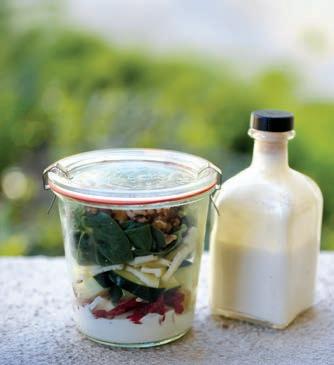
11108 N Frank Lloyd Wright Blvd, Ste E16 Scottsdale 732-832-1036
DimensionsOfHeavenAndEarth.com

Dimensions of Heaven and Earth is Scottsdale’s exciting, new one-stop Spiritual Experience: a center of healing and insight combined with a store full of unique gifts from local artisans. With training and tools for your personal development, we are excited to help you take your spiritual journey to new levels! See ad, page 21.
The Path of Spiritual Freedom 1-877-300-4949 • EckankarArizona.org Eckankar.org • HearHU.org Facebook.com/EckankarArizona

Eckankar is an active, individual, creative spiritual practice. A companion and roadmap for your journey home—to the heights of Self-Discovery and GodDiscovery, and beyond. Come along and discover the most secret part of yourself. The key to spiritual freedom lies within you. Explore life as a Soul Adventure. See ad, pagepage 25.

































